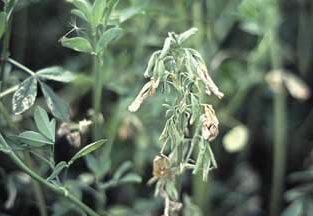Verticillium wilt disease of alfalfa is relatively new to California, having first been found in isolated fields in Humboldt and Monterey counties in 1985. Verticillium wilt is a disease caused by Verticillium albo-atrum alfalfa strain. Verticillium wilt is the most serious disease problem of alfalfa in the north-temperate areas of the United States, Canada, and Europe. In southern California the V. albo-atrum alfalfa strain was found in 28 of 52 fields sampled in Riverside and San Bernardino counties. Verticillium albo-atrum has a limited host range. The most important hosts of this pathogen include hops, alfalfa and cotton.
Symptoms of Verticillium wilt of alfalfa include bunchy top, short internodes, and upward curling of leaves on stem compared with healthy stem. Leaves may be wilted and pinkish to yellow on one side of stem. Compared with healthy leaf, diseased leaves show marginal and 